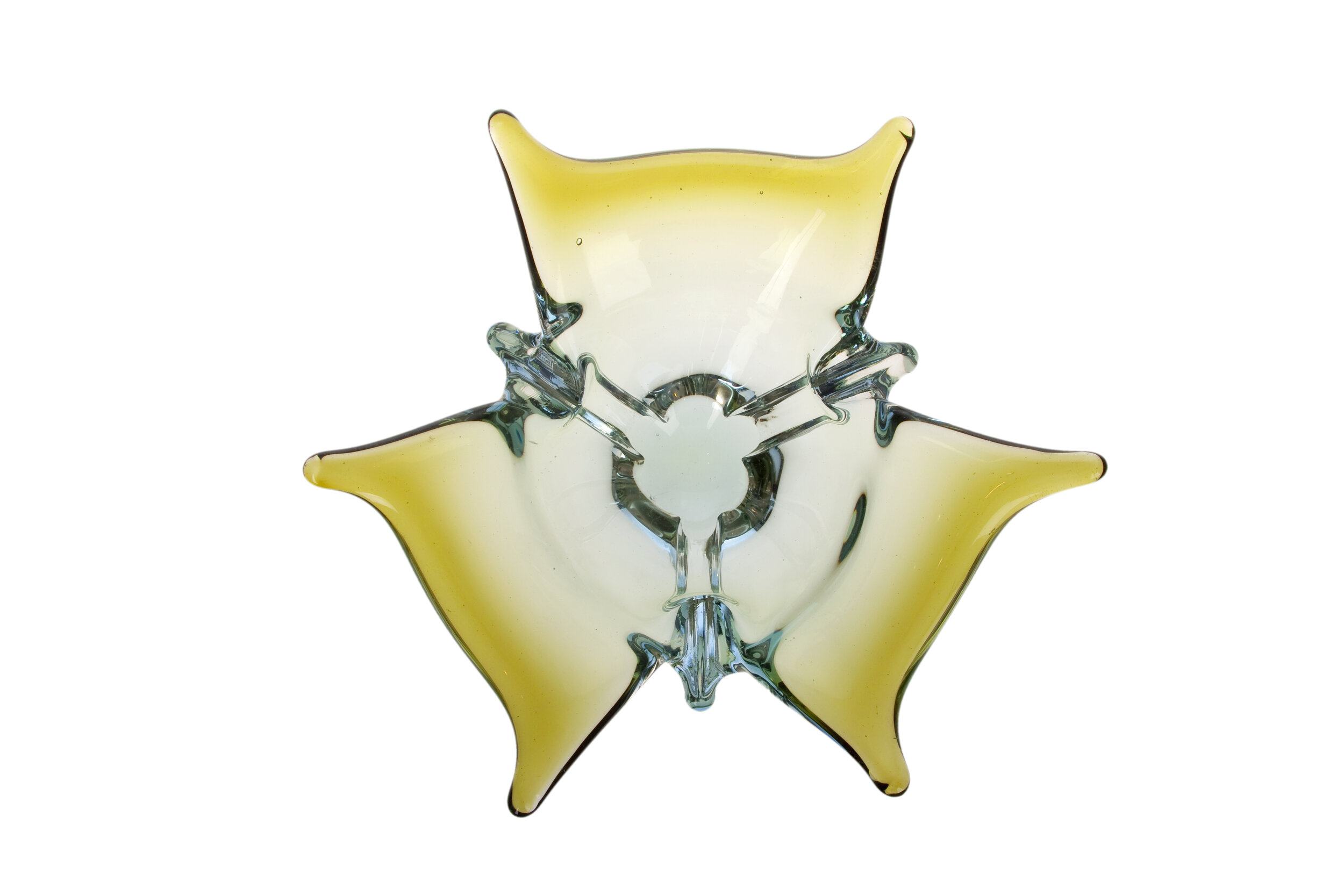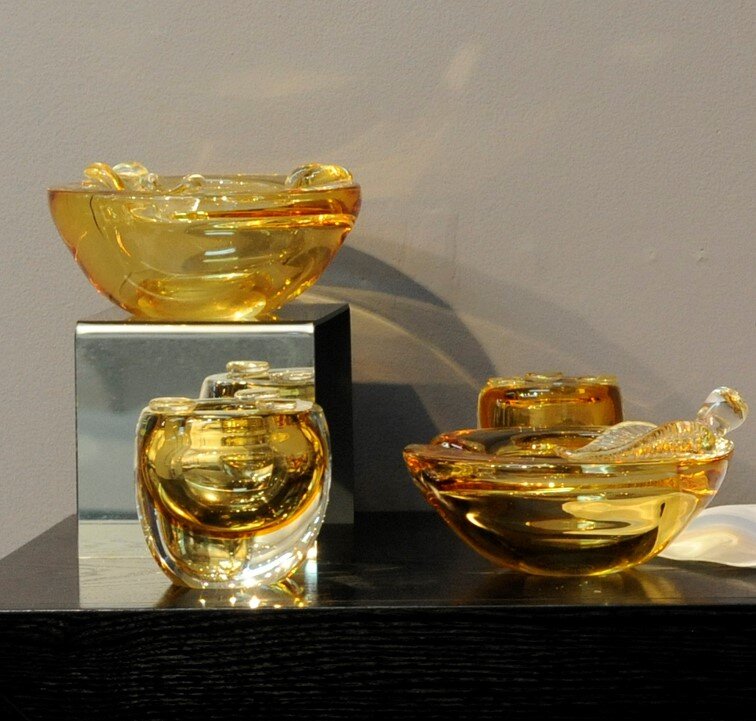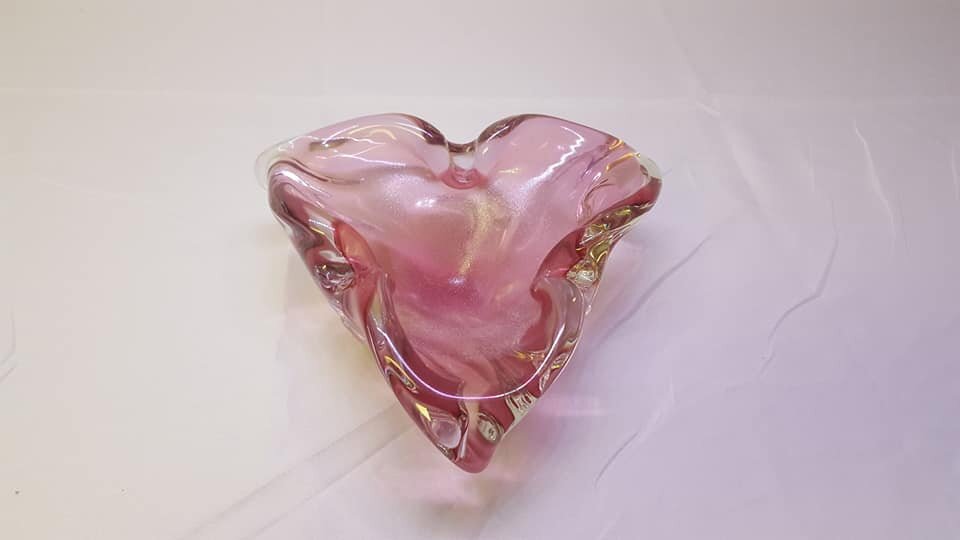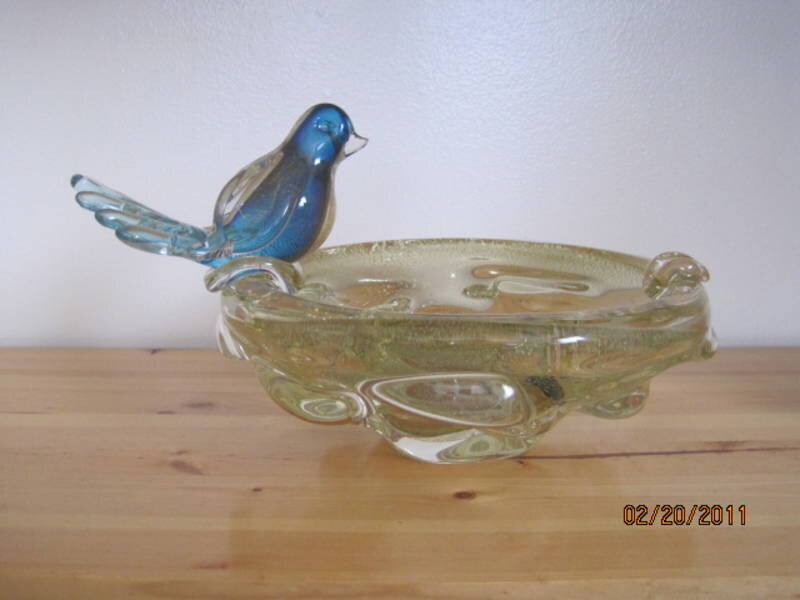The ashtray form-a 60’s art glass icon
It is impossible to find an art glass style more representational of its time than the ashtray. Why? Because it is a tangible symbol of the culture of the period in which it was created. In 1963, cigarettes were $0.35 a pack and cigarette consumption had risen for the seventh consecutive year. An estimated 45% of the population were smokers. A hugely significant commonality among citizens – you smoked in the workplace, in the home, in restaurants, in public institutions even such as hospitals, on airplanes, on transit… You were not banished to your back yard, to designated areas, car ashtrays and lighters were standard features, you would not be arrested and fined… There was no social stigma attached to being a smoker. The Surgeon General cigarette pack warning was two years out. Magazine, television, and bill board advertising was widespread – revenue from advertising tobacco products was in the billions. Anti-smoking movements would not start gaining impetus until the later 1970’s with most smoking restrictions and banning starting in the 1980s. And all the glass houses produced this piece – why would they not? Each produced it in dozens of styles, a myriad of colours, in 2 tones and in a huge range of sizes.
The smallest being the most intriguing – personal “hand held” ashtrays. These “micro” ashtrays were carried by the smoker as they moved about at parties, meetings etc. and then dumped into table placed larger ashtrays. The one shown here is 1.75” long x 1.25” wide x 1” high - small enough to fit in the palm of a hand. But cigar smokers need not feel ignored – their needs also received special attention.
Photographs courtesy of Paolo De Marchi. This ashtray was made by his father - Chalet artist Roberto De Marchi. Chalet produced quite a number of these for the hotel trade.
Chalet and Lorraine ashtrays and cigar bowls were done with both flat and pedestal bases. However, I have not, to date, seen an EDAG ashtray that has feet or pedestal bases – only flat bases. Some ashtrays were in shapes that do not bring an ashtray to today’s mind. However, if it has an indent on its rim – that is a “butt rest” and the piece is indeed an ashtray.
Piece on left has indents on its rim – ashtray. Piece on right has no indents on its rim – so not an ashtray but a dish.
Even though uniquely shaped,2 toned and with the very seldom seen divided interior – the rim has indents – “butt rests.” So yes, this too is an ashtray.
This Chalet piece might be very rare given its coloured base but it also has butt rests - so is also an ashtray. From the collection of Liz Crawford.
As are these from the Chalet ‘ Canadian Heritage Glass’ and ‘Canadiana Cranberry’ lines. Crystal ruffs and scalloped edges do not mean that the indents are not “butt rests.”
You will see the occasional ashtray with 1 butt rest but the most common are 2, 3 and 4 butt ashtrays. They do go up to 8 butts. They are found with all markings. Most of Chalet’s ashtrays were production pieces. However, we see common shapes in unusual colours, we see kicky little pieces and we also see cranberry and uranium pieces. In addition, we have also seen extremely rare Chalet pieces that are ashtrays - bullicante and forato pieces and a few with a corroso finish. There are also avventurina ashtrays The rarest were decorated with applied bird figurines. And a very, very, very few came in sets (see photo immediately below) with holders for the “ciggies.”
This rare ashtray and cigarette holder set from the collection of Chalet artist Antonio Tedesco. Shown here at the 2010 “Art and Artisans of Chalet Glass” exhibit, Cornwall, Ontario.
The iconic Chalet “4 leaf clover” shaped ashtray has 4 butt rests. This design was also done by Mosaic Artistic Glass and Lorraine Glass Industries as well as Chalet.
“8 butt” ashtray by Chalet. Most common markings - the “Chalet Canada” etched signature as well as the small Chantili sticker. They were produced in the full range of Chalet colours.
A common shape, the “splash” ashtray (3 butts) but in an uncommon colour and with an exceedingly uncommon marking as Riekes Crisa did not carry the Chalet coloured heavy leaded pieces..
A Chalet “forato’ ashtray and an EDAG “forato” ashtray. Which is which? To date, this ashtray form is the only Chalet forato found. Shown in the early “Items Available” brochure as A#40. Amber ashtray from the collection of “50 Shades” member Pierre Denis. Same style as the amber has also been found in blue.
Rare Chalet “bullicante” – a “4 butt” trillium ashtray. Another iconic Chalet ashtray design but a technique Chalet very, very seldom used. From the collection of ”50 Shades” member Bob Burgess.
Unusually shaped 2 butt ashtray. Signed with the etched “Chalet Canada” signature. Rimmed colour placement is also less commonly seen.
An example of a “1 butt” ashtray – and not a common one. This Chalet “apple” ashtray came in many colours but is not often found. It is large and has an applied crystal stem and avventurina leaf. Photo courtesy of Chalet Vintage Art Glass Gallery. A one butt pear shaped ashtray was also done with this same applied crystal stem and leaf details.
Another Chalet rarity is a piece with a “corroso” finish. Here it is found on the iconic “4 butt” trillium ashtray. Photo courtesy of “50 Shades” member Ryan Shawn Robertson.
Chalet did a very few ashtrays with applied bird and fish figurines. They are very rare and very unusual. They have been found with FASCINATION PAR C.M. markings, the Eaton’s marking and with the Chalet Canada etched signature.
Marked FASCINATION PAR C.M.
Etched “Chalet Canada” and note the silver avventurina throughout the bowl and the gold avventurina in the applied bird figurine.
This piece is marked with the Eaton’s branding. Also avventurina. Photo courtesy of “50 Shades” member Robin Thorpe.
Chalet cigar bowls came in a wide variety of shapes, colours and sizes and markings. The most common style is the “finger cigar bowl.”
Early production versions of the flat base “finger cigar bowl.” The amber (foreground) has the hand engraved “Birks” signature while the olive (background) bears the hand engraved “Russell’s” signature . From the collection of Deborah Patterson.
Each of these “finger cigar bowls” are etched “Chalet Canada” and/or stickered with Chalet labels. Footed pedestal base style (orange right foreground) is the later production design.
Although the “finger” design is the most commonly seen style of Chalet cigar bowl, we have seen some very atypical versions - completely clear, pink, one with a twisted “finger” and a “piccoli.”
This Chalet “mini” may be smaller in stature but it has huge impact.
Another flat base “finger cigar bowl” with a hand engraved signature - this piece is signed with the “Canada Art” hand engraved marking
The pedestal “finger cigar bowl” in the rear is a more elaborate design than the ones shown previously. It has the “Chalet Canada” etched signature.
This version is unusually coloured. And more unusually marked - bears the Canada Art” engraved signature.
Another style of Chalet specifically made for cigars. Large and heavy, this was produced in the full range of the Chalet colour palette.
My favourite style of Chalet cigar bowl has also been found in amber, blue and orange. Photograph courtesy of the Zhao family.
This style is very often found with the Eaton’s marking.
Throughout this article there have been numerous references that you may want to follow up. For information on the FB group “50 Shades of Chalet’ please see “The Group” . For more information regarding Chalet branding, refer to “The Books” and there is an article on FASCINATION PAR C.M. that details what we have learned. I would love to hear how you felt about this article, so please leave feedback. ask a question or remark in the “Comments’ directly below. I will respond promptly - promise!
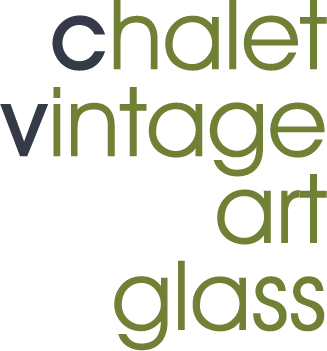


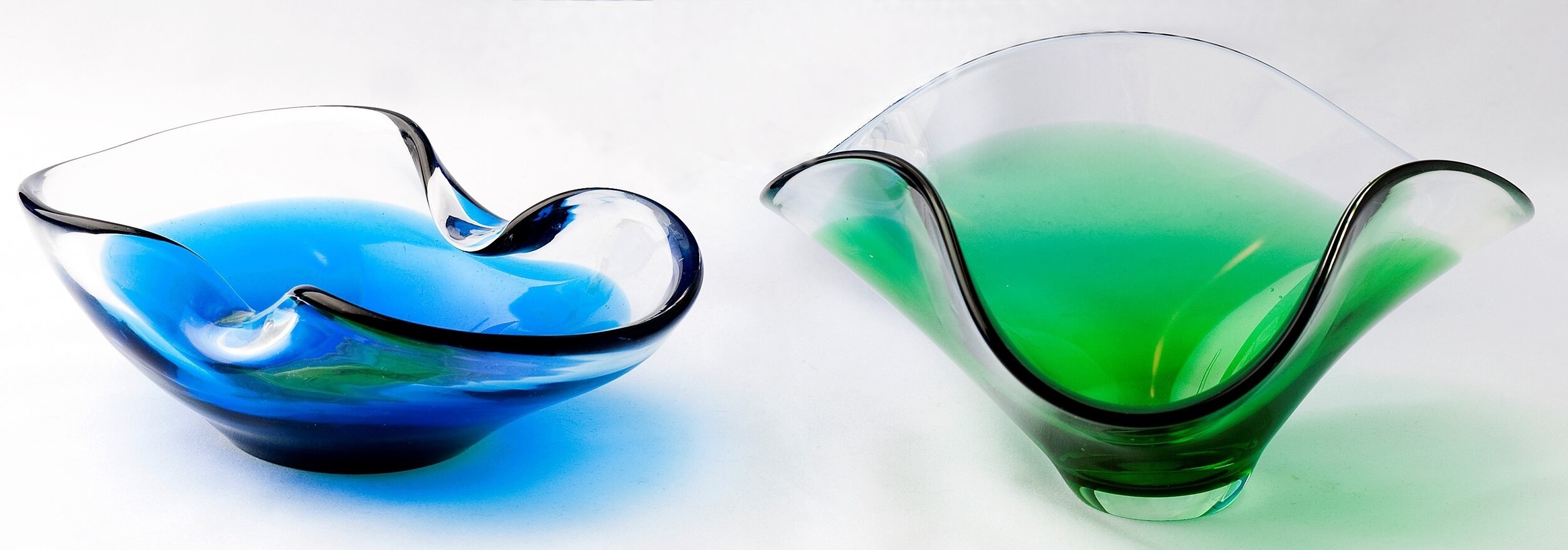
![756936132_tp[1].jpg](https://images.squarespace-cdn.com/content/v1/60132c343dcc51351d60f7ff/1619532588201-9Z39QH07HSOARRKBGF0G/756936132_tp%5B1%5D.jpg)
